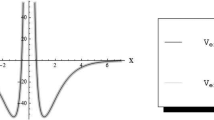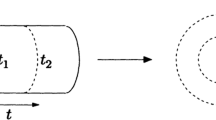Abstract
By using the supersymmetry quantum mechanics method, we approximately solve the Dirac equation for the modified Eckart potential and the modified deformed Hylleraas including Coulomb-like tensor potential under spin and pseudospin symmetry. We obtained approximate energy eigenvalues and the corresponding wave functions in terms of the Jacobi polynomial under the spin and pseudospin symmetries limit. In order to test the accuracy of our work, we compared our numerical results with that Nikiforov-Uvarov (NU) method. This shows that our results are consistent with those found in the literature.
Similar content being viewed by others
References
R. Lisboa, M. Malheiro, A. S. de Castro, P. Alberto, and M. Fiolhais, “Pseudospin symmetry and the relativistic harmonic oscillator,” Phys. Rev. C 69, 024319 (2004).
S. Zarrinkamar, A. A. Rajabi, and H. Hassanabadi, “Dirac equation for the harmonic scalar and vector potentials and linear plus Coulomb-like tensor potential the SUSY approach,” Ann. Phys. (N.Y.) 325, 2522 (2010).
J. N. Ginocchio, “U(3) and pseudo-U(3) symmetry of the relativistic harmonic oscillator,” Phys. Rev. Lett. 95, 252501 (2005).
S. Arbabi Moghadam, H. Mehraban, and M. Eshghi, “Eigen-spectra in the Dirac-attractive radial problem plus a tensor interaction under pseudospin and spin symmetry with the SUSY approach,” Chin. Phys. B 22, 100305 (2013).
J. Y. Gou, X. Z. Fang, and F. X. Xu, “Pseudospin symmetry in the relativistic harmonic oscillator,” Nucl. Phys. A 757, 411 (2005).
M. Eshghi, “Makarov potential in relativistic equation via Laplace transformation approach,” Can. J. Phys. 91, 71 (2013).
A. S. de Castro, P. Alberto, R. Lisboa, and M. Malheiro, “Relating pseudospin and spin symmetries through charge conjugation and chiral transformations: the case of the relativistic harmonic oscillator,” Phys. Rev. C 73, 054309 (2006).
M. Eshghi and H. Mehraban, “Solution of the Dirac equation with position-dependent mass for Q-parameter modified Pöschl–Teller and Coulomb-like tensor potential,” Few-Body Syst. 52, 41 (2012).
M. C. Zhang, G. H. Sun, and S. H. Dong, “Exactly complete solutions of the Schrödinger equation with a spherically harmonic oscillatory ring-shaped potential,” Phys. Lett. A 374, 704 (2010).
M. Eshghi, “Pseudo-harmonic oscillatory ring-shaped potential in a relativistic equation,” Chin. Phys. Lett. 29, 110304 (2012).
H. Hassanabadi, E. Maghsoodi, S. Zarrinkamar, and H. Rahimov, “An approximate solution of the Dirac equation for hyperbolic scalar and vector potentials and a Coulomb tensor interaction by SUSYQM,” Mod. Phys. Lett. A 26, 2703 (2011).
S. H. Dong, “A new quantization rule to the energy spectra for modified hyperbolic-type potentials,” Int. J. Quantum. Chem. 109, 701 (2009).
J. Y. Gou and Z. Q. Sheng, “Solution of the Dirac equation for the Woods–Saxon potential with spin and pseudospin symmetry,” Phys. Lett. A 338, 90 (2005).
G. F. Wei and S. H. Dong, “Spin symmetry in the relativistic symmetrical well potential including a proper approximation to the spin–orbit coupling term,” Phys. Scr. 81, 035009 (2010).
J. Y. Gou, J. C. Han, and R. D. Wang, “Pseudospin symmetry and the relativistic ring-shaped non-spherical harmonic oscillator,” Phys. Lett. A 353, 378 (2006).
C. S. Jia, T. Chen, and L. G. Gui, “Approximate analytical solutions of the Dirac equation with the generalized Pöschl–Teller potential including the pseudo-centrifugal term,” Phys. Lett. A 373, 1621 (2009).
C. Berkdemir, “Pseudospin symmetry in the relativistic Morse potential including the spin–orbit coupling term,” Nucl. Phys. A 770, 32 (2006).
M. Eshghi and M. Hamzavi, “Spin symmetry in Diracattractive radial problem and tensor potential,” Commun. Theor. Phys. 57, 355 (2012).
W. C. Qiang, R. S. Zhou, and Y. Gao, “Application of the exact quantization rule to the relativistic solution of the rotational Morse potential with pseudospin symmetry,” J. Phys. A: Math. Theor. 40, 11119 (2007)
W. C. Qiang, R. S. Zhou, and Y. Gao, J. Phys. A: Math. Theor. 40, 1677 (2007).
S. M. Ikhdair and R. Sever, “Application?of the inversion method to the heavy quarkonium systems,” Appl. Math. Commun. 216, 545 (2010).
O. Bayrak and I. Boztosun, “The pseudospin symmetric solution of the Morse potential for any κ State,” J. Phys. A: Math. Theor. 40, 11119 (2007).
G. F. Wei and S. H. Dong, “Approximately analytical solutions of the Manning–Rosen potential with the spin–orbit coupling term and spin symmetry,” Phys. Lett. A 373, 49 (2008).
C. S. Jia, P. Guo, and X. L. Peng, “Exact solution of the Dirac–Eckart problem with spin and pseudospin symmetry,” J. Phys. A: Math. Gen. 39, 7737 (2006).
C. S. Jia, J. Y. Liu, L. He, and L. T. Sun, “Pseudospin symmetry in the relativistic empirical potential as a diatomic molecular model,” Phys. Scr. 75, 388 (2007).
C. S. Jia, P. Guo, Y. F. Diao, L. Z. Yi, and X. J. Xie, “Solutions of Dirac equations with the Pöschl-Teller potential,” Eur. Phys. J. A 34, 41 (2007).
Y. P. Varshni, “Comparative study of potential energy functions for diatomic molecules,” Rev. Mod. Phys. 29, 664 (1957).
E. A. Hilleraas, “Energy formula and potential distribution of diatomic molecules,” J. Chem. Phys. 3, 595 (1935).
A. N. Ikot, O. A. Awoga, and A. D. Antia, “Bound state solutions of d-dimensional Schrödinger equation with Eckart potential plus modified deformed Hylleraas potential,” Chin. Phys. B 22, 020304 (2013).
S. H. Dong, W. C. Qiang, G. H. Sun, and V. B. Bezerra, “Analytical approximations to the l-wave solutions of the Schrödinger equation with the Eckart potential,” J. Phys. A 40, 10535 (2007).
H. Hassanabadi, E. Maghsoodi, N. Ikot Akpan, and S. Zarrinkamar, “Approximate arbitrary-state solutions of Dirac equation for modified deformed Hylleraas and modified Eckart potentials by the NU method,” Appl. Math. Comput. 219, 9388 (2013).
M. Hamzavi, A. A. Rajabi, and H. Hassanabadi, “Exact pseudospin symmetry solution of the Dirac equation for spatially-dependent mass Coulomb potential including a Coulomb-like tensor interaction via asymptotic iteration method,” Phys. Lett. A 374, 4303 (2010).
H. Akçay and C. Tezcan, “Exact solutions of the Dirac equation with harmonic oscillator potential including a Coulomb-like tensor potential,” Int. J. Mod. Phys. C 20, 931 (2009).
S. M. Ikhdair and R. Sever, “Approximate bound state solutions of Dirac equation with Hulthén potential including Coulomb-like tensor potential,” Appl. Math. Commun. 216, 911 (2010).
W. Greiner, Relativistic Quantum Mechanics-Wave Equation, 3rd ed. (Springer, Berlin, 2000).
J. D. Bjorken and S. D. Drell, Relativistic Quantum Mechanics (McGraw-Hill, New York, 1964).
J. N. Ginocchio, “The relativistic foundations of pseudospin symmetry in nuclei,” Nucl. Phys. A 654, 663 (1999).
J. N. Ginocchio, “A relativistic symmetry in nuclei,” Phys. Rep. 315, 231 (1999).
L. E. Gendenshtein, “Derivation of exact spectra of the Schrödinger equation by means of supersymmetry,” JETP Lett. 38, 356 (1983).
F. Cooper, A. Khare, and U. Sukhatme, “Supersymmetry and quantum mechanics,” Phys. Rep. 251, 276 (1995).
Author information
Authors and Affiliations
Corresponding author
Additional information
The article is published in the original.
Rights and permissions
About this article
Cite this article
Moghadam, S.A., Mehraban, H. & Khoshmehr, H.H. The energy eigenvalues of Dirac equation with the modified Eckart and modified deformed Hylleraas potential by shape invariance approach. Phys. Part. Nuclei Lett. 12, 667–679 (2015). https://doi.org/10.1134/S154747711505009X
Published:
Issue Date:
DOI: https://doi.org/10.1134/S154747711505009X




